 IAS on Facebook IAS on Facebook
 IAS on Instagram IAS on Instagram

|

IAS Aroid Quasi Forum
About Aroid-L
This is a continuously updated archive of the Aroid-L mailing list in a forum format - not an actual Forum. If you want to post, you will still need to register for the Aroid-L mailing list and send your postings by e-mail for moderation in the normal way.
|
Species suited to a water wall
|
From: Paul Temple <paulindr at gmail.com> on 2009.04.21 at 03:54:25(19259)
Hi.
A friend advised that this list sometimes discusses water walls and the species that suit them.
Ihave a new water wall. It's about 5 feet high and about 20 feet long. Rocks are already turning green after just a week of water includingseveral dry spells (to fix leaks!). I live at 1400 metres above sealevel in the Dominican Republic so day temperatures can be as high as32C (often cooler) and nights drop to as low as 6C. The wall isexposed to strong sunlight for several hours a day. The water isneutral and direct from a river. The rocks are probably neutral (butmay tend towards alkaline - I must test this).
If anyone can suggest specific plant species or varieties (not necessarily aroids) thatwould be either interesting or attractive, I'd be grateful. I'mrelatively knowledgeable about carnivorous plants and not new tospecialist gardening, so I'm looking for something a little morehelpful than generalities (so for example, being told that "ferns" aregood would be no real help).
Thanks for any suggestions, especially if replies are copied directly to me.
Cheers
Paul Temple
| HTML +More |
Constanza / Aguas Blancas
Domnican Republic--00163616469161ca800468089a2f----==============„13853438334501169=� |
|
From: "John Criswick" <criswick at spiceisle.com> on 2009.04.21 at 22:05:27(19261)
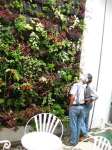
As it happens, I just returned from Cali, Colombiawhere my host Alvaro Calonje took me to see a wet wall he had made in anupmarket business place. In the attached picture, Alvaro is standing on theright.
Cali isabout 1,000 metres above sea level but nearer the equator than the DR. Temperaturesare definitely cooler than where I am at 250 metres altitude in Grenada, 12degrees north. For instance, I saw spathiphyllums planted in full sun indowntown Cali. But it never gets anything near as low as 6C !
I don’t think there are any aroids on the wallexcept the white and green form of Pothos. There are a profusion ofalternantheras and types of ground cover, begonias, vinca, (the plant known as periwinklein temperate gardens), ivies, maidenhair ferns, peperomias, selaginellas,zebrinas, and creeping plectranthus would be a good one too.
John. | HTML +More | |
From:aroid-l-bounces@gizmoworks.com [mailto:aroid-l-bounces@gizmoworks.com] On Behalf Of Paul Temple
Sent: Monday, April 20, 2009 8:54PM
To: aroid-l@gizmoworks.com
Subject: [Aroid-l] Species suitedto a water wall
Hi.
A friend advised that this list sometimes discusses water walls and the speciesthat suit them.
I have a new water wall. It's about 5 feet high and about 20 feetlong. Rocks are already turning green after just a week of water includingseveral dry spells (to fix leaks!). I live at 1400 metres above sea levelin the Dominican Republic so day temperatures can be as high as 32C (oftencooler) and nights drop to as low as 6C. The wall is exposed to strongsunlight for several hours a day. The water is neutral and direct from ariver. The rocks are probably neutral (but may tend towards alkaline - Imust test this).
If anyone can suggest specific plant species or varieties (not necessarilyaroids) that would be either interesting or attractive, I'd be grateful. I'm relatively knowledgeable about carnivorous plants and not new tospecialist gardening, so I'm looking for something a little more helpfulthan generalities (so for example, being told that "ferns" are goodwould be no real help).
Thanks for any suggestions, especially if replies are copied directly to me.
Cheers
Paul Temple
Constanza / Aguas Blancas
Domnican Republic
------=_NextPart_001_00D1_01C9C292.9CE077E0--------=_NextPart_000_00D0_01C9C292.9CE077E0 |
|
From: "Lengyel Ferenc" <Ferenc.Lengyel at aok.pte.hu> on 2009.04.22 at 07:38:28(19264)
Hello,
Firt of all I'm terribly sorry for loading the list with such a big mail. I haven't realized its size, I
just added the attachments one after the other without reducing their size. Next time I will
take care of it.
Thank you for all the answers. Yes, it has a white sap when cut. So it must be the juvenile
form of a Syngonium sp., possibly S. macrophyllum.
The unknown plant on the aroid webpage mentioned by Marek Argent is very similar,
however, it has a shiny surface while the upper surface of the leaves of my plant is slightly
velvety.
If anybody is interested in the attached pics, I have reduced their size and put them on the
Internet. Here are the links:
http://img0.tar.hu/lengyelf/img/37600892.jpg#3
http://img0.tar.hu/lengyelf/img/37600891.jpg#3
http://img0.tar.hu/lengyelf/img/37600890.jpg#3
http://img0.tar.hu/lengyelf/img/37600889.jpg#3
http://img0.tar.hu/lengyelf/img/37600888.jpg#3
http://img0.tar.hu/lengyelf/img/37600887.jpg#3
Best Regards
Ferenc
| +More |
_______________________________________________
Aroid-L mailing list
Aroid-L@www.gizmoworks.com
http://www.gizmoworks.com/mailman/listinfo/aroid-l
|
|
From: bonaventure at optonline.net on 2009.04.22 at 21:09:17(19266)
Paul, you can try epiphytic/lithophytic orchids.
Bonaventure
| HTML +More | |
--Boundary_(ID_qju9fvS9dsY2wnIDk3cYGw)
_______________________________________________
Aroid-L mailing list
Aroid-L@www.gizmoworks.com
http://www.gizmoworks.com/mailman/listinfo/aroid-l
--==============$57329315563495237==--
|
|
From: George Yao <geoyao at gmail.com> on 2009.04.23 at 11:35:25(19269)
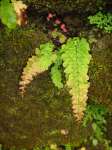
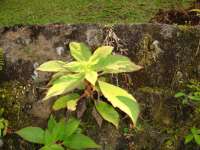
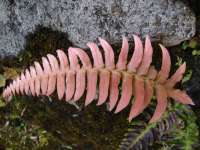
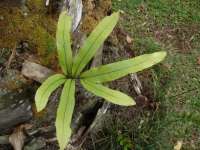
Hello Paul,
On my trip to Wilson Botanical Garden in Costa Rica last year, I saw these plants (pictures attached) growing on a damp wall exposed to sunlight. I recall that I also saw begonias, but I couldn't find pictures.
George Yao
| HTML +More | |
Metro-Manila
Philippines
On 04/21/09, at 11:54 AM, Paul Temple wrote:
Hi.
A friend advised that this list sometimes discusses water walls and the species that suit them.
I have a new water wall. It's about 5 feet high and about 20 feet long. Rocks are already turning green after just a week of water including several dry spells (to fix leaks!). I live at 1400 metres above sea level in the Dominican Republic so day temperatures can be as high as 32C (often cooler) and nights drop to as low as 6C. The wall is exposed to strong sunlight for several hours a day. The water is neutral and direct from a river. The rocks are probably neutral (but may tend towards alkaline - I must test this).
If anyone can suggest specific plant species or varieties (not necessarily aroids) that would be either interesting or attractive, I'd be grateful. I'm relatively knowledgeable about carnivorous plants and not new to specialist gardening, so I'm looking for something a little more helpful than generalities (so for example, being told that "ferns" are good would be no real help).
Thanks for any suggestions, especially if replies are copied directly to me.
Cheers
Paul Temple
Constanza / Aguas Blancas
Domnican Republic _______________________________________________
Aroid-L mailing list
Aroid-L@www.gizmoworks.com
http://www.gizmoworks.com/mailman/listinfo/aroid-l
--Apple-Mail-42-186320769Content-Disposition: inline; filename=DSC01780.jpgContent-Transfer-Encoding: base64 |
|
From: "Elizabeth Campbell" <desinadora at mail2designer.com> on 2009.04.23 at 14:10:02(19271)
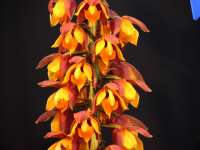
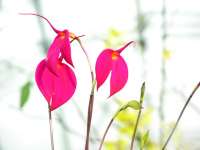
Building on what Bonaventure had to say, I'd reccomend the epilythic members of Maxillaria and Masdevallia (see attached), which are smaller-growing plants with rather spectacularly coloured blooms, and if you want something very big and showy you can actually move to the epiphytes of most species so long as you anchor them in living moss (which from your description won't be a problem.) If you're going to go that way, then I'd reccomend some of the orchids that produce a pendant, rather than erect, inflorescence - genera like Stanhopea, Acineta, and Lycaste. I've attached a photo of a Colombian Acineta hybrid that is grown to great success on water-walls. The orchid show only labeled this one "Acineta gymnostele x, Colombia" (they didn't give the grower's name) so I can't give you pointers on where you might find one. However, A. superba is also a fantastic plant, widely available, and smells amazing.
You can also grow many of the Ecuadorean species of Philodendron this way; I can vouch for P. pastazense growing at the margins of waterfalls. Equally, epiphytic bromeliads of the genera Tillandsia and Neoregelia perform well on water-walls.
Hope this helps!
Beth
| HTML +More | |
_______________________________________________________________
Get the Free email that has everyone talking at http://www.mail2world.com
Unlimited Email Storage – POP3 – Calendar – SMS – Translator – Much More!------=_NextPart_001_12F7_01C9C3E2.85898FE0--------=_NextPart_000_12F6_01C9C3E2.85898FE0 |
|
From: Riley2362 at aol.com on 2009.04.23 at 23:40:21(19273)
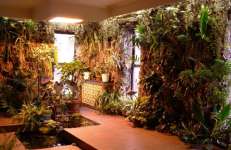
Well, there are "water walls" and there are "water walls", meaning that there is no generic definition of such. Yours sounds more like an Ecuadorean mountainside, which is quite exciting and has infinite possibilities. My walls are much different in their substrate, their water source, their light source, their temperature range and, the fact that they are in a New York City apartment on the second floor of a building. Other than that ... everything is the same. You will identify a thousand little ecosystems with all variations of the above required elements and then you start to figure out what will grow there. Then, if they are not happy you move them, quickly, before they die. It is purely a horticultural situation because you control all or most of the elements and their consistency. What a great and exciting challenge, but there are no easy answers.
Michael Riley
| HTML +More | |
New York NY
Big savings on Dell XPS Laptops and Desktops!
--ce8.51b6ed55_alt_bound----part1_ce8.51b6ed55.37225665_rel_boundaryContent-ID: |
|
From: "windy aubrey" <exotics at hawaii.rr.com> on 2009.04.24 at 00:51:08(19275)
Hi Paul,
I love the idea of a rock/water wall. >From the plants I grow maybe I can offer you a few suggestions.
I think you could use many of the epiphytic ferns. Some that would 'work' well would be species of Microgramma, Asplenium, Elaphoglossum, Davallia, Pyrrosia, Microsorum, Polypodium, etc. There are several species of Microgramma that sty miniature in size and will develop into an attractive blanket of tiny fronds.
You might want to consider other ferns too, like Pteris, Adiantum, Blechnum, Microlepia, but beware of Nephrolepis.
Nepholepis tends to become a weed and will either over spore on to your rock surfaces or send out it's thin stolons that produce tubers and will become next to impossible to remove once the tubers grow in between the rock crevasses.
Selaginella loves moist rocks and there are several species offering different looks, colors and growing patterns.
Lycopodium, the epiphytic types of club moss, would also do nicely.
If you want aroids, the Homalomena love water and some species stay low growing. Cyrtosperma enjoy being wet too, and so do the Spathiphyllum. The species Spathiphyllum florabundum stay small and compact.
You might want to try something like Rhipsalis too. Small cuttings could be tucked into the spaces between the rocks and it will grow nicely, being epiphytic and would look good being pendulant.
Rhizomatous Begonias do really well growing around moist rocks, and they offer some beautiful foliage color and patterns as well as tall flower spikes. Some are also miniature, or small growing so they won't crowd out other plants.
Re: Carnivorous plants, could a Nepenthes be used? Although I grow Nepenthes mostly in hanging baskets I know in nature they ramble on the ground around rocks and such. I recently planted one to grow around some Volcanic rocks outlining a planting area and it seems happy growing and creeping around.
I hope some of these plants will give you more ideas for your wall, and when it is complete you will share some images with us.
Windy
| HTML +More | |
PS If you need species names or pictures, just drop me a note.
------=_NextPart_000_00E1_01C9C422.EF78BFD0----==============p84015821925647529=� |
|
From: "Christopher Rogers" <crogers at ecoanalysts.com> on 2009.04.24 at 02:58:52(19277)
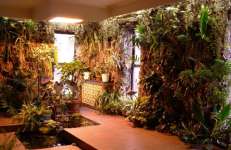
Wow. Michael, that is fantastic.
So, how does one build a water wall. What is the principle behind it?
D. Christopher Rogers
| HTML +More | |
Senior Invertebrate Ecologist/ Taxonomist
((,///////////=======<
EcoAnalysts, Inc.
1.530.383.4798
P.O. Box 4098
Davis, CA 95616
USA
ŸInvertebrate Taxonomy
ŸEndangered Species
ŸEcological Studies
ŸBioassessment
ŸInvasive Species
ŸPlankton
ŸPhycology
IDAHO ∙ CALIFORNIA ∙ MISSOURI ∙ PENNSYLVANIA ∙ ONTARIO
WWW.ECOANALYSTS.COM ∙ ECO@ECOANALYSTS.COM
From: aroid-l-bounces@gizmoworks.com [mailto:aroid-l-bounces@gizmoworks.com] On Behalf Of Riley2362@aol.com
Sent: Thursday, April 23, 2009 4:40 PM
To: aroid-l@gizmoworks.com
Subject: Re: [Aroid-l] Species suited to a water wall
Well, there are "water walls" and there are "water walls", meaning that there is no generic definition of such. Yours sounds more like an Ecuadorean mountainside, which is quite exciting and has infinite possibilities. My walls are much different in their substrate, their water source, their light source, their temperature range and, the fact that they are in a New York City apartment on the second floor of a building. Other than that ... everything is the same. You will identify a thousand little ecosystems with all variations of the above required elements and then you start to figure out what will grow there. Then, if they are not happy you move them, quickly, before they die. It is purely a horticultural situation because you control all or most of the elements and their consistency. What a great and exciting challenge, but there are no easy answers.
Michael Riley
New York NY
_____
Big savings on Dell XPS Laptops and Desktops!
No virus found in this incoming message.
Checked by AVG - www.avg.com
Version: 8.0.238 / Virus Database: 270.12.3/2076 - Release Date: 04/23/09 06:30:00
------=_NextPart_001_017D_01C9C44D.ED40E9B0
_______________________________________________
Aroid-L mailing list
Aroid-L@www.gizmoworks.com
http://www.gizmoworks.com/mailman/listinfo/aroid-l
--==============�33620328656127041==--
|
|
From: "windy aubrey" <exotics at hawaii.rr.com> on 2009.04.24 at 03:06:40(19278)
TOO-OOO COOL Michael!!
I sell plants time to time to collectors in NY and often fantasize on how their apartments might look.
Now I can really appreciate the full intensity and devotion a plant grower like yourself has gone into to produce such a fantastic home for these tropicals.
Could you elaborate on your set up? I need to know more. It truly is beautiful.
Thanks for sharing,
Windy
| HTML +More | |
----- Original Message -----
From: Riley2362@aol.com
To: aroid-l@gizmoworks.com
Sent: Thursday, April 23, 2009 1:40 PM
Subject: Re: [Aroid-l] Species suited to a water wall
Well, there are "water walls" and there are "water walls", meaning that there is no generic definition of such. Yours sounds more like an Ecuadorean mountainside, which is quite exciting and has infinite possibilities. My walls are much different in their substrate, their water source, their light source, their temperature range and, the fact that they are in a New York City apartment on the second floor of a building. Other than that ... everything is the same. You will identify a thousand little ecosystems with all variations of the above required elements and then you start to figure out what will grow there. Then, if they are not happy you move them, quickly, before they die. It is purely a horticultural situation because you control all or most of the elements and their consistency. What a great and exciting challenge, but there are no easy answers.
Michael Riley
New York NY
Big savings on Dell XPS Laptops and Desktops!
_______________________________________________
Aroid-L mailing list
Aroid-L@www.gizmoworks.com
http://www.gizmoworks.com/mailman/listinfo/aroid-l
------=_NextPart_001_0111_01C9C435.DF401740--------=_NextPart_000_0110_01C9C435.DF401740 |
|
From: bonaventure at optonline.net on 2009.04.29 at 20:37:01(19294)
Yep mike, really cool (yuk,yuk, pun). I forgot Lepanthes in my list in my last msg. I deal with 2 things that kill these little jewels in central New Jersey - July and August. I'm sure many of you out there have the same experience with certain Anthuriums and other aroids. My sprouting Arisaema speciosum outdoors just turned to mush with the string of 90F+ days we just had.
Mike, you in GNYOS? bonaventure@optonline.net
Bonaventure
| HTML +More | |
--Boundary_(ID_T7ooHMgEcHQ8S2qOIGA7PQ)----==============#92530552641482249=� |
| |
Note: this is a very old post, so no reply function is available.
|
|











